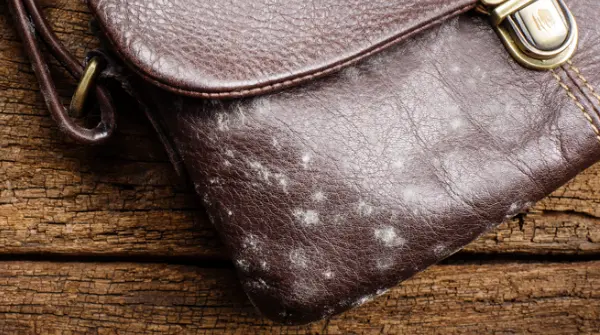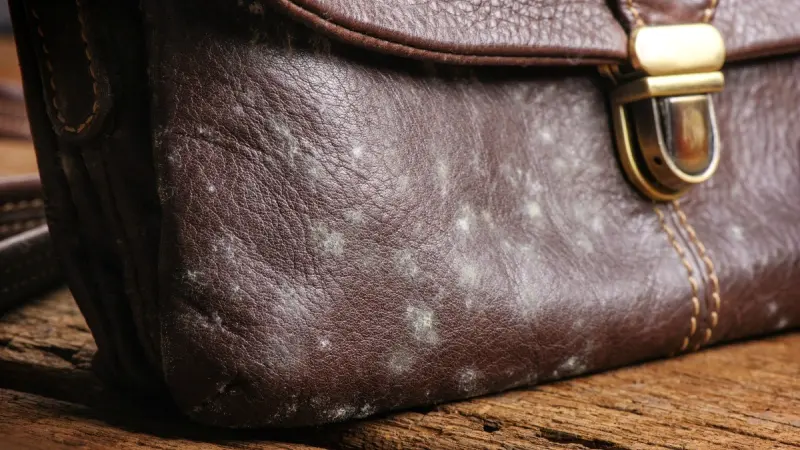How to Remove Mold & Mildew from Leather Bags
Mold and mildew are a type of fungus that flourishes in natural, damp, and warm environments. Leather bags that are not stored correctly in a dry and shaded setting or have been exposed to moist and damp environments can often develop mold.
Mold grows on all kinds of leather bags, including leather handbags, purses, gym bags, briefcases, or satchels. Typically, you will notice mold only on the exterior of the leather bag, and not on the interior lining.
Once you spot any mold or mildew spots, you should treat them right away to ensure that your leather bag doesn’t get permanently damaged. Moreover, when ignored, your leather bag can develop a musty and unpleasant odor that is difficult to get rid of. Check out our guide on removing odor from leather bags for more information.
Mold can also damage its texture and cause discoloration and fading. Therefore, it’s best to treat it as soon as possible. Here’s are the 5 steps to removing mold and mildew from leather bags:
- Identify Affected Areas
- Brush Off Mold & Mildew Spores
- Disinfect Mold & Mildew Spots
- Clean & Condition Your Leather Bag
- Store Your Leather Bag Correctly
Ensure that you follow this easy step-by-step process for optimal results. We’ve also included a section where we list some of the best practices and answer some of the most frequently asked questions when it comes to treating mold and mildew on leather bags.
Why Do Mold and Mildew Grow on Leather Bags?
Mold and mildew are fungi that form dark or whitish furry patches on leather as they begin to grow together on the material. Moisture and warmth are the two leading causes of mold growth since insufficient airflow (when leather is damp) and excessive heat on a natural material create the perfect environment for mold to thrive.

When you store leather bags in the darkness of your closet, where the environment is humid and hot, mold begins to form on the surface leaving unsightly spots on leather that can be very difficult to clean.
Dark and unventilated closets also happen to be how many people store their leather bags, which promotes the growth of mildew and mold. This can potentially damage leather bags well before their lifetime. Therefore, it’s always best to treat it right away.
1. Identify Affected Areas
To begin cleaning your mildew or mold-affected leather bag, you should inspect it carefully by carrying it by the handles. Look carefully around the sides, top, and bottom of the bag to determine which sections need to be cleaned.
You must be diligent with the process because if mold is not removed carefully, there is a high chance of regrowth, and you will have to redo everything from scratch.
You should also inspect if the mold growth of the bag is too extensive to be treated at home. If your leather handbag or briefcase is expensive and holds sentimental value, it may be best to employ a professional cleaning service. However, we’ve tested our process on all types of leather bags with great success.
Also, take note that both mold and mildew are treated the same way. Therefore, you’ll be able to apply this treatment to all types of stains that derive from fungal growth.
2. Brush Off Mold & Mildew Spores
After determining which areas on your leather bag have mold, you should use a horsehair brush or any type of soft brush to wipe away mold spores. Use a light hand to clean the surface of your leather bag and don’t apply too much pressure on the surface.
The main aim is only to remove the superficial effects of mold growth on your leather bag so that thorough cleaning and future prevention are much easier in the upcoming steps.
3. Disinfect Mold & Mildew Spots
Although we would advise against applying rubbing alcohol on leather (since it can affect the color of the leather and can also harm its protective layer), using it in a diluted solution with equal parts water, will do the perfect job of disinfecting your leather bag and eliminating mold without causing any discoloration or damage.
Make a mixture of rubbing alcohol (isopropyl alcohol) with water in a 1:1 ratio. Use a microfiber cloth to remove persisting mold stains. Remember to keep using unsoiled parts of the cloth while cleaning to ensure that no transference takes place.
If the cloth gets completely soiled before this step is completed, wash and wring it in water until it’s clean and can be used again to remove the remaining mold stains.
This step ensures that any form of mold and mildew is removed from your leather bag and the surface is disinfected before you start the cleaning process.
4. Clean & Condition Your Leather Bag
After wiping the bag thoroughly with a rubbing alcohol and water solution, you should move on to cleaning and conditioning the bag to add a glossy and protective layer. You can use saddle soap or any dedicated leather cleaner for the purpose.
While you’re able to use any type of saddle soap, we prefer using Fiebing’s Saddle Soap (yellow), as it works well on leather bags, giving it a glossy and nourishing shine. It even works well on branded leather bags!
Take a soft cloth and rub a small amount of saddle soap on the bag’s surface with a thin, even coating. Remove the saddle soap with a dry clean cloth and use a leather conditioner afterward for better protection against mold regrowth.
The leather conditioner will be applied using similar steps used in the cleaning process, after which your bag will be well-guarded against water and other foreign substances from affecting the porous leather surface.
5. Store Your Leather Bag Correctly
Storing your leather bag correctly is the most crucial step since keeping it in the same conditions will result in repeated mold and mildew growth. Therefore, you’ll need to change the way you store your leather bag.
Ensure to store your leather bag in a dry, well-ventilated, and cool space such as ventilated closets or closets with dehumidifiers, or dust bags (since they are breathable and protect against impurities).
You can also place silica gel packets or activated charcoal into your leather bag to absorb most of the moisture. Moreover, you should also air your leather bag out once a month in a shaded and airy space.
Important Tips for Removing Mold & Mildew from Leather Bags
Following the above-mentioned steps will remove any form of mold or mildew from your leather bag. But we also wanted to share some important tips and best practices that you can apply when following our proven process.
- Don’t Use Acetone – Cleaning mold with acetone can irreversibly damage your beloved leather bag. Acetone can weaken leather fiber structures from within, causing leather to peel away and discolor due to harsh chemical effects. Feel free to read more on the effects of acetone on leather.
- Don’t Use Chemicals – Strong cleaning agents (not made for leather) that contain a high concentration of alcohol or other harsh chemicals can be harmful to leather. These substances can deteriorate leather and the bonds that hold it together.
- Prevention Is Better Than Cure – We advise you to always follow the proper care instructions for cleaning, drying, and storing your leather bag. It’s better to prevent mold from occurring than having to remove it, as it could damage your leather.
- Store Your Leather Bag Correctly – Storing a leather bag correctly can help you prevent brittleness caused by harsh sunlight and mold due to damp and warm environments.
- Understand Your Environment – Pay close attention to the climate and environment you store your leather bags in since that will dictate how you should care for them, in order to prevent mold and mildew growth.
Frequently Asked Questions
As this guide was designed to give you a comprehensive overview on removing mold and mildew from all types of leather bags, we also wanted to ensure to answer some of the questions that you may have.
Are Mold & Mildew Stains On Leather Bags Permanent?
Most fungal stains such as mold and mildew are surface-level stains that can be removed relatively quickly. However, fungal stains that penetrate your leather can be hard to remove and can even lead to permanent damage.
Therefore, you should remove any type of mold stains the moment you spot them. Also, ensure that you store your leather bags appropriately in the first place.
Can Mold on Leather Bags Be a Health Hazard?
Yes, mold can produce irritants and allergens, which can be harmful. This may cause allergic reactions when carrying your leather bag or when getting exposed to them. Therefore, always ensure that your leather bags are regularly cleaned and mold-free at all times.

About Gerrit
Co-Founder, Researcher & Writer At Leatherskill
I’m a leather enthusiast who spends most of his free time crafting, researching, and writing about the many facets of this versatile material. Thanks for reading!

